CAT Exam > CAT Questions > Directions: Study the given information and a...
Start Learning for Free
Directions: Study the given information and answer the following question.
In a quiz competition, two academies - Alex Academy and Zed Academy - with five groups each competed against each other such that each group of an academy competed against all the five groups of the other academy exactly once. In any round, the winner was given three points, and the loser was awarded no points. In case of a draw, the two groups were awarded one point each.
The table below provides partial information about the wins, draws and losses of each group:
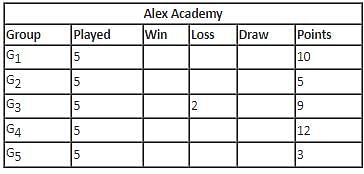
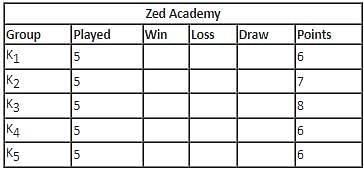
Moreover, it is also known that:
(A) Each group won at least one round.
(B) G1 lost the round against K5, while G4 lost against K1.


Moreover, it is also known that:
(A) Each group won at least one round.
(B) G1 lost the round against K5, while G4 lost against K1.
The total number of rounds that K4 lost was _________.
Correct answer is '3'. Can you explain this answer?
| FREE This question is part of | Download PDF Attempt this Test |
Most Upvoted Answer
Directions: Study the given information and answer the following quest...
Since G1 has 10 points, it must have won 3 rounds and drew 1 round (winning 2 and drawing 4 is not possible). G2 could have won 1 round and drew 2 rounds or drew all 5 rounds. From A, G2 must have won 1 round and drew 2 rounds. Since G3 has two losses, it must have won the remaining 3 rounds for 9 points. G4 must have won 4 rounds and lost 1 round, and G5 must have won 1 round and lost 4 rounds.
In Zed Academy. K1 could have 2 wins or 1 win and 3 draws. K2 could have 2 wins and 1 draw or 1 win and 4 draws. K3 must have 2 wins and 2 draws. K4 and K5 each can have 2 wins or 1 win and 3 draws.
The total number of draws that the groups in Zed Academy can have is 3 (since the total number of draws in Alex Academy is 3). Since K3 already has 2 draws, the only possibility is K2 having 2 wins and 1 draw.
Therefore, K1, K4 and K5 each has 2 wins and 3 losses.
The table below presents this information:
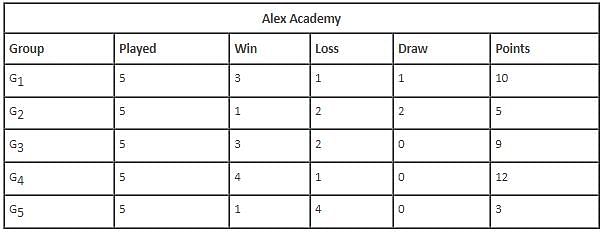
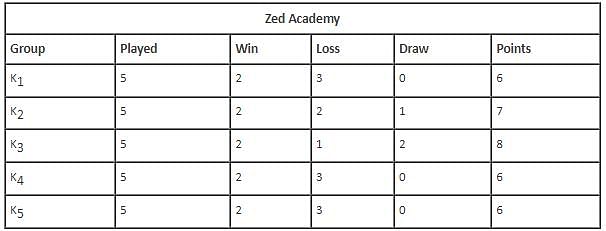
Since G1 and G2 drew 3 rounds and K2 and K3 also drew three rounds, G2 must have drawn against both K2 and K3 while G1 must have drawn against K3. Since G4 lost against K1, it must have won all the remaining rounds. Since G1 lost against K5, it must have won against K1, K2 and K4.
K2 lost to G1 and G4. Hence, it must have won against G3 and G5. K3 lost to G4. Hence, it must have won against G3 and G5. Since G3 lost two rounds, it must have won the rounds against K1, K4 and K5. K4 must have won against G2 and G5. The table below gives the results of the rounds (with the group that won the round in each cell and '-' representing a draw).
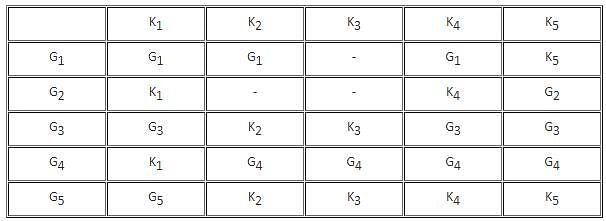
K4 lost three rounds.
In Zed Academy. K1 could have 2 wins or 1 win and 3 draws. K2 could have 2 wins and 1 draw or 1 win and 4 draws. K3 must have 2 wins and 2 draws. K4 and K5 each can have 2 wins or 1 win and 3 draws.
The total number of draws that the groups in Zed Academy can have is 3 (since the total number of draws in Alex Academy is 3). Since K3 already has 2 draws, the only possibility is K2 having 2 wins and 1 draw.
Therefore, K1, K4 and K5 each has 2 wins and 3 losses.
The table below presents this information:


Since G1 and G2 drew 3 rounds and K2 and K3 also drew three rounds, G2 must have drawn against both K2 and K3 while G1 must have drawn against K3. Since G4 lost against K1, it must have won all the remaining rounds. Since G1 lost against K5, it must have won against K1, K2 and K4.
K2 lost to G1 and G4. Hence, it must have won against G3 and G5. K3 lost to G4. Hence, it must have won against G3 and G5. Since G3 lost two rounds, it must have won the rounds against K1, K4 and K5. K4 must have won against G2 and G5. The table below gives the results of the rounds (with the group that won the round in each cell and '-' representing a draw).

K4 lost three rounds.
Attention CAT Students!
To make sure you are not studying endlessly, EduRev has designed CAT study material, with Structured Courses, Videos, & Test Series. Plus get personalized analysis, doubt solving and improvement plans to achieve a great score in CAT.

|
Explore Courses for CAT exam
|

|
Similar CAT Doubts
Directions: Study the given information and answer the following question.In a quiz competition, two academies - Alex Academy and Zed Academy - with five groups each competed against each other such that each group of an academy competed against all the five groups of the other academy exactly once. In any round, the winner was given three points, and the loser was awarded no points. In case of a draw, the two groups were awarded one point each.The table below provides partial information about the wins, draws and losses of each group:Moreover, it is also known that:(A) Each group won at least one round.(B) G1 lost the round against K5, while G4 lost against K1.The total number of rounds that K4 lost was _________.Correct answer is '3'. Can you explain this answer?
Question Description
Directions: Study the given information and answer the following question.In a quiz competition, two academies - Alex Academy and Zed Academy - with five groups each competed against each other such that each group of an academy competed against all the five groups of the other academy exactly once. In any round, the winner was given three points, and the loser was awarded no points. In case of a draw, the two groups were awarded one point each.The table below provides partial information about the wins, draws and losses of each group:Moreover, it is also known that:(A) Each group won at least one round.(B) G1 lost the round against K5, while G4 lost against K1.The total number of rounds that K4 lost was _________.Correct answer is '3'. Can you explain this answer? for CAT 2024 is part of CAT preparation. The Question and answers have been prepared according to the CAT exam syllabus. Information about Directions: Study the given information and answer the following question.In a quiz competition, two academies - Alex Academy and Zed Academy - with five groups each competed against each other such that each group of an academy competed against all the five groups of the other academy exactly once. In any round, the winner was given three points, and the loser was awarded no points. In case of a draw, the two groups were awarded one point each.The table below provides partial information about the wins, draws and losses of each group:Moreover, it is also known that:(A) Each group won at least one round.(B) G1 lost the round against K5, while G4 lost against K1.The total number of rounds that K4 lost was _________.Correct answer is '3'. Can you explain this answer? covers all topics & solutions for CAT 2024 Exam. Find important definitions, questions, meanings, examples, exercises and tests below for Directions: Study the given information and answer the following question.In a quiz competition, two academies - Alex Academy and Zed Academy - with five groups each competed against each other such that each group of an academy competed against all the five groups of the other academy exactly once. In any round, the winner was given three points, and the loser was awarded no points. In case of a draw, the two groups were awarded one point each.The table below provides partial information about the wins, draws and losses of each group:Moreover, it is also known that:(A) Each group won at least one round.(B) G1 lost the round against K5, while G4 lost against K1.The total number of rounds that K4 lost was _________.Correct answer is '3'. Can you explain this answer?.
Directions: Study the given information and answer the following question.In a quiz competition, two academies - Alex Academy and Zed Academy - with five groups each competed against each other such that each group of an academy competed against all the five groups of the other academy exactly once. In any round, the winner was given three points, and the loser was awarded no points. In case of a draw, the two groups were awarded one point each.The table below provides partial information about the wins, draws and losses of each group:Moreover, it is also known that:(A) Each group won at least one round.(B) G1 lost the round against K5, while G4 lost against K1.The total number of rounds that K4 lost was _________.Correct answer is '3'. Can you explain this answer? for CAT 2024 is part of CAT preparation. The Question and answers have been prepared according to the CAT exam syllabus. Information about Directions: Study the given information and answer the following question.In a quiz competition, two academies - Alex Academy and Zed Academy - with five groups each competed against each other such that each group of an academy competed against all the five groups of the other academy exactly once. In any round, the winner was given three points, and the loser was awarded no points. In case of a draw, the two groups were awarded one point each.The table below provides partial information about the wins, draws and losses of each group:Moreover, it is also known that:(A) Each group won at least one round.(B) G1 lost the round against K5, while G4 lost against K1.The total number of rounds that K4 lost was _________.Correct answer is '3'. Can you explain this answer? covers all topics & solutions for CAT 2024 Exam. Find important definitions, questions, meanings, examples, exercises and tests below for Directions: Study the given information and answer the following question.In a quiz competition, two academies - Alex Academy and Zed Academy - with five groups each competed against each other such that each group of an academy competed against all the five groups of the other academy exactly once. In any round, the winner was given three points, and the loser was awarded no points. In case of a draw, the two groups were awarded one point each.The table below provides partial information about the wins, draws and losses of each group:Moreover, it is also known that:(A) Each group won at least one round.(B) G1 lost the round against K5, while G4 lost against K1.The total number of rounds that K4 lost was _________.Correct answer is '3'. Can you explain this answer?.
Solutions for Directions: Study the given information and answer the following question.In a quiz competition, two academies - Alex Academy and Zed Academy - with five groups each competed against each other such that each group of an academy competed against all the five groups of the other academy exactly once. In any round, the winner was given three points, and the loser was awarded no points. In case of a draw, the two groups were awarded one point each.The table below provides partial information about the wins, draws and losses of each group:Moreover, it is also known that:(A) Each group won at least one round.(B) G1 lost the round against K5, while G4 lost against K1.The total number of rounds that K4 lost was _________.Correct answer is '3'. Can you explain this answer? in English & in Hindi are available as part of our courses for CAT.
Download more important topics, notes, lectures and mock test series for CAT Exam by signing up for free.
Here you can find the meaning of Directions: Study the given information and answer the following question.In a quiz competition, two academies - Alex Academy and Zed Academy - with five groups each competed against each other such that each group of an academy competed against all the five groups of the other academy exactly once. In any round, the winner was given three points, and the loser was awarded no points. In case of a draw, the two groups were awarded one point each.The table below provides partial information about the wins, draws and losses of each group:Moreover, it is also known that:(A) Each group won at least one round.(B) G1 lost the round against K5, while G4 lost against K1.The total number of rounds that K4 lost was _________.Correct answer is '3'. Can you explain this answer? defined & explained in the simplest way possible. Besides giving the explanation of
Directions: Study the given information and answer the following question.In a quiz competition, two academies - Alex Academy and Zed Academy - with five groups each competed against each other such that each group of an academy competed against all the five groups of the other academy exactly once. In any round, the winner was given three points, and the loser was awarded no points. In case of a draw, the two groups were awarded one point each.The table below provides partial information about the wins, draws and losses of each group:Moreover, it is also known that:(A) Each group won at least one round.(B) G1 lost the round against K5, while G4 lost against K1.The total number of rounds that K4 lost was _________.Correct answer is '3'. Can you explain this answer?, a detailed solution for Directions: Study the given information and answer the following question.In a quiz competition, two academies - Alex Academy and Zed Academy - with five groups each competed against each other such that each group of an academy competed against all the five groups of the other academy exactly once. In any round, the winner was given three points, and the loser was awarded no points. In case of a draw, the two groups were awarded one point each.The table below provides partial information about the wins, draws and losses of each group:Moreover, it is also known that:(A) Each group won at least one round.(B) G1 lost the round against K5, while G4 lost against K1.The total number of rounds that K4 lost was _________.Correct answer is '3'. Can you explain this answer? has been provided alongside types of Directions: Study the given information and answer the following question.In a quiz competition, two academies - Alex Academy and Zed Academy - with five groups each competed against each other such that each group of an academy competed against all the five groups of the other academy exactly once. In any round, the winner was given three points, and the loser was awarded no points. In case of a draw, the two groups were awarded one point each.The table below provides partial information about the wins, draws and losses of each group:Moreover, it is also known that:(A) Each group won at least one round.(B) G1 lost the round against K5, while G4 lost against K1.The total number of rounds that K4 lost was _________.Correct answer is '3'. Can you explain this answer? theory, EduRev gives you an
ample number of questions to practice Directions: Study the given information and answer the following question.In a quiz competition, two academies - Alex Academy and Zed Academy - with five groups each competed against each other such that each group of an academy competed against all the five groups of the other academy exactly once. In any round, the winner was given three points, and the loser was awarded no points. In case of a draw, the two groups were awarded one point each.The table below provides partial information about the wins, draws and losses of each group:Moreover, it is also known that:(A) Each group won at least one round.(B) G1 lost the round against K5, while G4 lost against K1.The total number of rounds that K4 lost was _________.Correct answer is '3'. Can you explain this answer? tests, examples and also practice CAT tests.

|
Explore Courses for CAT exam
|

|
Suggested Free Tests
Signup for Free!
Signup to see your scores go up within 7 days! Learn & Practice with 1000+ FREE Notes, Videos & Tests.
























